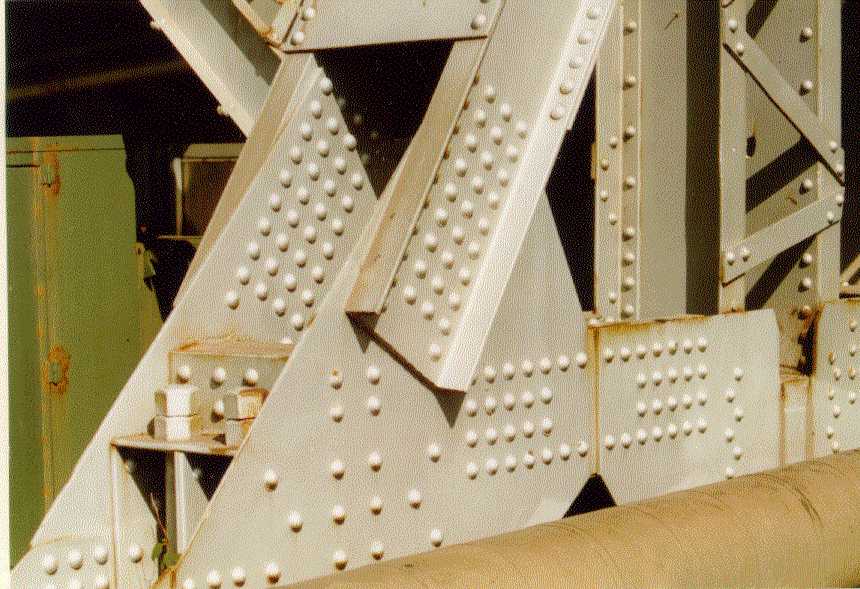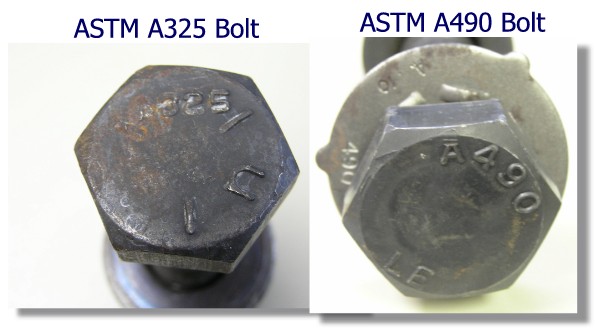|
|
Section 2.3
Bolts
Last Revised: 05/31/2023
Bolting is a very common method of fastening steel members. Bolting is particularly cost effective in the field.
|
Figure 2.3.1 |
 |
The precursor to bolting was riveting. You will probably have occasion to assess connections made with rivets sometime in your career, particularly if you work on restoration projects. Riveting was a very dangerous and time consuming process. It involved heating the rivets to make them malleable then inserting them in hole and flattening the heads on both sides of the connection. The process required an intense heat source and a crew of three or more workers. Figure 2.3.1 shows a riveted connection in a bridge structure.
In the mid 1900s, high strength bolts were introduced and quickly replaced rivets as the preferred method for connecting members together in the field because of their ease of installation and more consistent strengths. High strength is necessary since most bolts are highly tensioned in order to create large clamping forces between the connected elements. They also need lots of bearing and shear strength so as to reduce the number of fasteners needed.
Historically, there were two basic ASTM high strength bolt specifications and one non-high strength ASTM bolt specification. The high strength bolts were ASTM A325 and ASTM A490. The non-high strength bolt is ASTM A307.
The SCM requirements are founded on the Specification for Structural Joints Using High-Strength Bolts. This specification has evolved in the last couple of decades, resulting in corresponding changes in the specification.
In 2016, the ASTM A325 and ASTM A490 specifications were consolidated, along with the A325M, A490M, F1852, and F2280 specifications into the ASTM F3125 specification. Each of the former specifications are grades in the F3125 specification. For the purposes of this text, the bolts will be referred to by their grade title.
New with the SCM 14th edition was the introduction of bolt "Groups" in SCM J3.1 for high strength bolts, per the new requirements of the Specification for Structural Joints Using High-Strength Bolts. A325 bolts were assigned to "Group A" while A490 bolts are assigned to "Group B". A third group, "Group C" containing ASTM F3043 and F3111 bolts, was added in the SCM 15th edition to accommodate the new 220 ksi high-strength bolts. In the SCM 16th edition, the groups have been revised and renamed according to the ultimate strengths of the bolts within the groups. Group 120 (formerly Group A in the 15th Edition), Groups 144 & 150 (formerly Group B in the 15th Edition), and Group 150 (formerly Group C in the 15th Edition).
ASTM A307 bolts are not assigned to a group since they are not considered to be high strength bolts.
Read SCM J3.2 to see the groups that the various bolts are assigned to. The grouping is important as the design values for bolts are assigned by group.
For the purposes of this text, we focus on the more commonly used grade A325 and grade A490 bolts.
The ultimate tensile strengths for A325 and A490 bolts are 120 ksi and 150 ksi respectively. These values are rarely needed in applying the equations in the AISC specification but are useful to know when using theoretical equations for special circumstances. We will also be obtaining bolt strength information for use in the AISC equations from SCM Table J3.2 on page 16.1-137. We'll cover that table in more detail later.
|
Figure 2.3.2 |
 |
The ASTM bolt specifications require that the bolts and their associated nuts and washers be clearly identified with their specification number. Figure 2.3.2 shows the identifiers for A325 and A490 bolts.